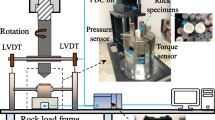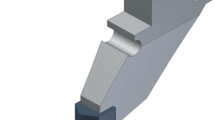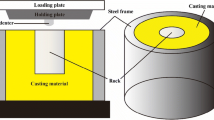Abstract
Drillability indices, i.e., the Drilling Rate Index™ (DRI), Bit Wear Index™ (BWI), Cutter Life Index™ (CLI), and Vickers Hardness Number Rock (VHNR), are indirect measures of rock drillability. These indices are recognized as providing practical characterization of rock properties used in the Norwegian University of Science and Technology (NTNU) time and cost prediction models available for hard rock tunneling and surface excavation. The tests form the foundation of various hard rock equipment capacity and performance prediction methods. In this paper, application of the tests for tunnel boring machine (TBM) and drill and blast (D&B) tunneling is investigated and the impact of the indices on excavation time and costs is presented.










Similar content being viewed by others
Notes
CNO is abbreviation of Construtora Norberto Odebrecht S.A. of Brazil.
GEO96 is a geological consulting company in Switzerland.
References
Blindheim OT, Bruland A (1998) Boreability testing, in Norwegian TBM Tunnelling, Publication No. 11, Norwegian Tunnelling Society
Bruland A (1998a) Hard rock tunnel boring. PhD thesis, Department of Civil and Transport Engineering, NTNU, Trondheim, Norway
Bruland A (1998b) Prediction model for performance and costs, in Norwegian TBM Tunnelling, Publication No. 11, Norwegian Tunnelling Society
CNO (1998) Tender documents: San Francisco Tunnel geology and geotechnical description summary. (Unpublished)
Dahl F (2003) Draft of DRI, BWI, CLI standard. Available at http://www.drillability.com. Accessed 8 Nov 2011
Dahl F, Grøv E, Breivik T (2007) Development of a new direct test method for estimating cutter life, based on the Sievers’ J miniature drill test. J TUST 22:106–116
GEO 96 (2003) Report no. 00B13-1: assessment of rock support classes TBM penetration rates and cutter wear rates. (Unpublished)
NTNU (1998a) Report 13A-98 drillability—test methods. Department of Civil and Transport Engineering, Trondheim
NTNU (1998b) Report 13B-98 drillability—catalogue of drillability indices. Department of Civil and Transport Engineering, Trondheim
NTNU (1998c) Report 13C-98 drillability—statistics of drillability test results. Department of Civil and Transport Engineering, Trondheim
NTNU (1998d) Report 1A-98 hard rock tunnel boring—design and construction. Department of Civil and Transport Engineering, Trondheim
NTNU (1998e) Report 1B-98 hard rock tunnel boring—advance rate and cutter wear. Department of Civil and Transport Engineering, Trondheim
NTNU (1998f) Report 1C-98 hard rock tunnel boring—costs. Department of Civil and Transport Engineering, Trondheim
NTNU (1998g) Report 1D-98 hard rock tunnel boring—geology and site investigations. Department of Civil and Transport Engineering, Trondheim
NTNU (1998h) Report 1E-98 hard rock tunnel boring—performance data and back-mapping. Department of Civil and Transport Engineering, Trondheim
NTNU (1998i) Report 1F-98 hard rock tunnel boring—the boring process. Department of Civil and Transport Engineering, Trondheim
NTNU (1998j) The FULLPROF software. Department of Civil and Transport Engineering, Trondheim
NTNU (2007a) Report 2A-05 drill and blast tunnelling—blast design. Department of Civil and Transport Engineering, Trondheim
NTNU (2007b) Report 2B-05 drill and blast tunnelling—advance rate. Department of Civil and Transport Engineering, Trondheim
NTNU (2007c) Report 2C-05 drill and blast tunnelling—costs. Department of Civil and Transport Engineering, Trondheim
NTNU (2009) Report 12C-08 rock quarrying—bench drilling. Department of Civil and Transport Enginering, Trondheim
Selmer-Olsen R, Lien R (1960) Bergarters borbarhet og sprengbarhet. Teknisk Ukeblad nr. 34, Oslo, pp 3–11
SINTEF (1998) Report no. 98032: Testing of Rock Core Samples from San Francisco Tunnel—Ecuador. (Unpublished)
Thuro K (1997) Drillability Prediction: Geological Influences in Hard Rock Drill and Blast Tunneling, vol 86. Geol Rundsch, Springer, pp 426–438
Zare S (2007) Prediction model and simulation tool for time and costs of drill and blast tunnelling. PhD thesis, Department of Civil and Transport Engineering, NTNU, Trondheim, Norway
Acknowledgments
The authors wish to thank CNO, GEO96, and SINTEF for the respective reports. The NTNU reports are available to anyone requesting them; see, e.g., http://www.tunnel.no/article.php?id=199 or send an email to amund.bruland@ntnu.no.
Author information
Authors and Affiliations
Corresponding author
Rights and permissions
About this article
Cite this article
Zare, S., Bruland, A. Applications of NTNU/SINTEF Drillability Indices in Hard Rock Tunneling. Rock Mech Rock Eng 46, 179–187 (2013). https://doi.org/10.1007/s00603-012-0253-y
Received:
Accepted:
Published:
Issue Date:
DOI: https://doi.org/10.1007/s00603-012-0253-y




